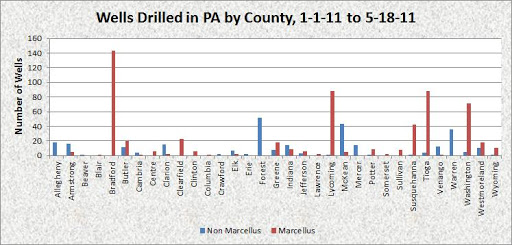A legal plan to control drilling
by David Slottje, JD and Helen Holden Slottje, JD – Community Environmental Defense Council, Inc.
What comes to mind when you think about upstate New York? Rolling farmlands, fresh air, and the chirping of birds? Or heavy truck traffic at all hours of the day and night, the smell of chemicals in the air, distant views pockmarked with drilling rigs, and the stars blocked from sight by light pollution?
Many community groups and municipal leaders are becoming increasingly alarmed by the threats attendant to unconventional gas drilling. These communities are growing frustrated with what they perceive to be the unwillingness of state and federal politicians and agencies to act decisively. Can anything be done at the local level to protect the health and welfare of our communities? The answer is yes, at least in New York.
We are lawyers with the Community Environmental Defense Council, Inc., a pro bono, public interest environmental law firm based in Ithaca. It is our opinion that a New York municipality has the legal authority and right to use land-use laws of general applicability (such as zoning laws) to prohibit what we have termed “high-impact industrial uses,” either in certain zoning districts or throughout an entire town.
Furthermore, we believe this authority and power legally may be exercised in a manner that, depending upon the municipality’s particular definition of “high-impact industrial uses,” will have the incidental effect of prohibiting (within the town) land uses such as unconventional gas drilling.
Some people have heard that municipalities are legally restricted from enacting laws to prohibit certain uses, such as “adult entertainment,” and so they wonder whether those same restrictions might also apply to banning industrial uses. They do not.
Those restrictions on “adult entertainment” are very limited and very specific in nature, and have to do with protection of constitutional rights, specifically First Amendment rights, including free speech.
There is no question that exclusion of industrial uses is a proper and legitimate use of land-use laws.
The United States Supreme Court addressed this question in a 1974 case known as Village of Belle Terre. In Belle Terre, the court stated that the town had wide latitude to use its zoning laws to protect the public welfare, and that the public welfare is spiritual, as well as physical, aesthetic and monetary. The court specifically held that a town may use its police power “to lay out zones where the blessings of quiet seclusion and clean air make the area a sanctuary for people.”
And the New York Court of Appeals — the highest court of New York State — came to the same conclusion in a 1996 case called Gernatt Asphalt Products. This was a situation in which a town had used its zoning power to ban mining as a permitted use, and the people who wanted to mine challenged the ban, saying that the ban involved unconstitutional exclusionary zoning.
We have never held that the exclusionary zoning test, which is intended to prevent a municipality from improperly using the zoning power to keep people out, also applies to prevent the exclusion of industrial uses. […] A municipality is not obligated to permit the exploitation of any and all natural resources within the town as a permitted use, if limiting that use is a reasonable exercise of its police power to prevent damage to the rights of others and to promote the interests of the community as a whole. (Emphasis added.)
So, there should be no doubt that a New York State municipality has the legal right to use land-use laws to ban industrial uses.
You may have heard the opinion that New York has preempted the right of municipalities to ban certain specifically articulated industrial uses — oil and gas drilling and solution mining — within their boundaries.
We believe that the state has not preempted such activities, so long as they happen to fall within the definition of “high-impact industrial uses” contained in a town’s properly enacted zoning law.
There is a state statute (the “drilling statute”) that precludes municipalities from regulating the oil, gas, and solution mining industries, but we believe “regulating” means regulating the operational processes of the industry—that is, things such as how deep they can drill or mine, and imposition of bonding requirements. Municipalities may, in fact, prohibit such industries outright, either in certain zoning districts or throughout an entire town.
The drilling statute language regarding regulation is almost identical to the language regarding regulation that was previously used in the context of the mineral mining statute, and in that context the Court of Appeals made it crystal clear that the scope of preempted regulation meant regulation related to operational processes, and that municipalities absolutely could prohibit mining outright, whether in certain zoning districts or throughout an entire town.
Simply put, our recommendation to New York State municipalities seeking to preserve their character and avoid industrialization is to adopt a zoning law or amendment that specifically prohibits high-impact industrial uses within the municipality, and to utilize a definition of “high-impact industrial use” which encompasses unconventional gas drilling and any other uses determined to be inimical to the municipality’s desired character and goals.
We do not believe that our interpretation is particularly bold, or visionary, or out-of-the box. Embracing our approach does not involve attempting to create new law, or attempting to overturn any law, or even trying to distinguish a holding in an unfavorable judicial decision.
There are people out there who do not agree with our approach. Our view is that the vast majority of them are people who have a financial stake in seeing drilling go forward: drilling companies and their lawyers, landowners who favor drilling, and their lawyers—many of whom will receive substantial fees if drilling is allowed to proceed.
We would be happy to speak with the representatives of any municipality, or any community group, who wish to discuss the concepts we are recommending, the specifics of creating the type of law we are suggesting, or how to minimize political and legal “push-back” risks. We are pro bono attorneys, which means we do not charge for our time.
David Slottje is executive director and senior attorney, and Helen Holden Slottje is managing attorney, at the Community Environmental Defense Council, Inc. (CEDC). Both are members of the Club’s Atlantic Chapter. CEDC is a 501(c)(3) non-profit, pro bono, public interest environmental law firm. For more information about CEDC or to contact the authors, visit CEDC’s web site.
Copyright SierraClub 2009











